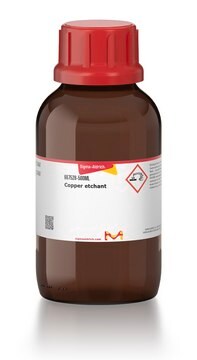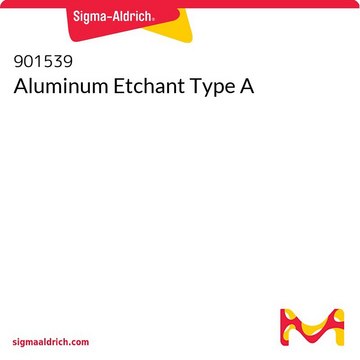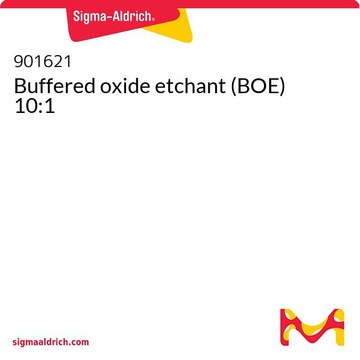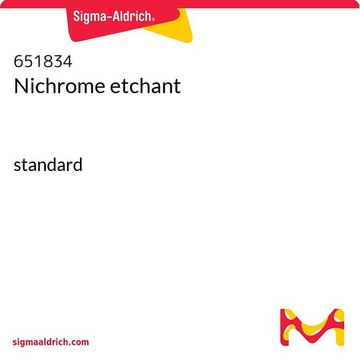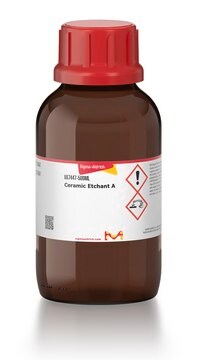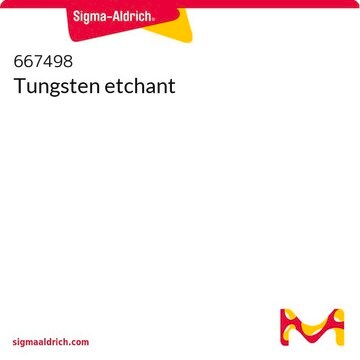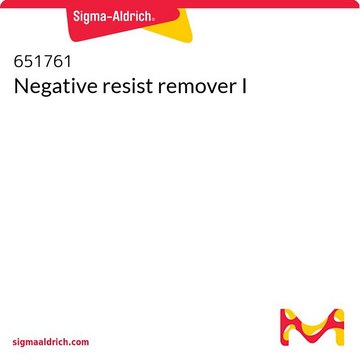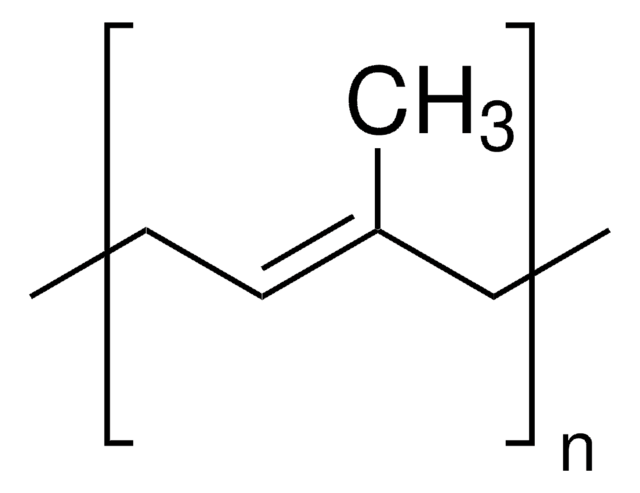651826
Chromium etchant
standard
Synonym(s):
Cr etching solution
Sign Into View Organizational & Contract Pricing
All Photos(1)
About This Item
Recommended Products
grade
standard
Quality Level
composition
volatiles, 85%
color
orange
bp
100 °C/1 atm
density
1.16 g/mL at 25 °C
Related Categories
General description
- Appearance - Clear orange
- pH - Acidic
- Etch Rate at 40 °C - 40 Å/second
- Etch Capacity (rate declines at ~70%) - 65 g/gallon
- Shelf Life - 1 year
- Storage Conditions - Ambient
- Filtration - 0.2 µm
- Recommended Operating Temperatures - 20-80 °C (30-40 °C most common)
- Rinse - Deionized water
- Photoresist Recommendations - KLT6000 Series, KLT 5300 Series, HARE SQT (SU-8 type), TRANSIST, or PKP -308PI
- Select Compatible Materials - Au, Ti, oxide, nitride, Si
- Select Incompatible Materials - Al, Ni, Cu, NiCr
- Compatible Plastics - HDPE, PP, PTFE, PFA, PVC
- Isotropy - Isotropic
- Incompatible Chemicals - Strong bases
Ceric ammonium nitrate-based etchant. Etch rate of 40 Å/sec @ room temp. Etches cleanly with only a deionized water rinse needed.
Chromium etchant is a chromium based solution that removes the excess metal from the substrate. These etchants are majorly used in metal finishing and electronic industry. It has an etch rate of 4 mm/s and can be used to etch nickel, copper, and chromium based excess metals.
Our chromium etchant is high purity ceric ammonium nitrate system for precise, clean etching of chromium and chromium oxide films. Compatible with positive and negative photoresists. Our chromium etchant is filtered to remove all particulates above 0.2 microns. Etching temperature varies depending on film thickness. Etch times range from 15 seconds to 60 seconds at room temperature. Chromium Etchants should be operated in a well-ventilated hood.
Application
For use at room temperature or elevated temperature. Etches cleanly, eliminating need for an intermediate rinse. Etching temperature varies with regard to film thickness. Etch times range from 15 to 60 seconds at room temperature. Note, chromium etchants should be handled in a well ventilated hood.
The product can etch Al, Cr, Cu, Ni, GaAs. It can surface oxidize Si, Ta/TaN, however, it has no effect on Au, Si3N4, SiO2, Ti, and W surfaces
Features and Benefits
Designed for precise, clean etching of chromium and chromium oxide films. Compatible with both positive and negative photoresists. Filtered to 0.2 micron to remove particlulates.
Signal Word
Danger
Hazard Statements
Precautionary Statements
Hazard Classifications
Aquatic Chronic 2 - Eye Dam. 1 - Met. Corr. 1 - Ox. Liq. 2 - Skin Corr. 1B - Skin Sens. 1
Supplementary Hazards
Storage Class Code
5.1B - Oxidizing hazardous materials
WGK
WGK 3
Flash Point(F)
Not applicable
Flash Point(C)
Not applicable
Choose from one of the most recent versions:
Already Own This Product?
Find documentation for the products that you have recently purchased in the Document Library.
Customers Also Viewed
Reconstituting Functional Microtubule-Barrier Interactions.
Methods in Cell Biology, 120(5), 69-90 (2014)
Fabrication and Mechanical Properties Measurements of 3D Microtissues for the Study of Cell-Matrix Interactions.
The Surfaceome, 120(5), 303-328 (2018)
The regeneration and recycle of chromium etching solutions using concentrator cell membrane technology.
Chaudhary AJ, et al.
Chemosphere, 62(5), 841-846 (2006)
Pressure-driven Fermi surface reconstruction of chromium
Stillwell RL, et al.
Physical Review, 88(12) (2013)
F J Alfaro-Mozaz et al.
Nature communications, 8, 15624-15624 (2017-06-08)
Polaritons in layered materials-including van der Waals materials-exhibit hyperbolic dispersion and strong field confinement, which makes them highly attractive for applications including optical nanofocusing, sensing and control of spontaneous emission. Here we report a near-field study of polaritonic Fabry-Perot resonances
Protocols
Negative Photoresist Procedure
Global Trade Item Number
| SKU | GTIN |
|---|---|
| 651826-500ML | 4061832732657 |
Our team of scientists has experience in all areas of research including Life Science, Material Science, Chemical Synthesis, Chromatography, Analytical and many others.
Contact Technical Service
